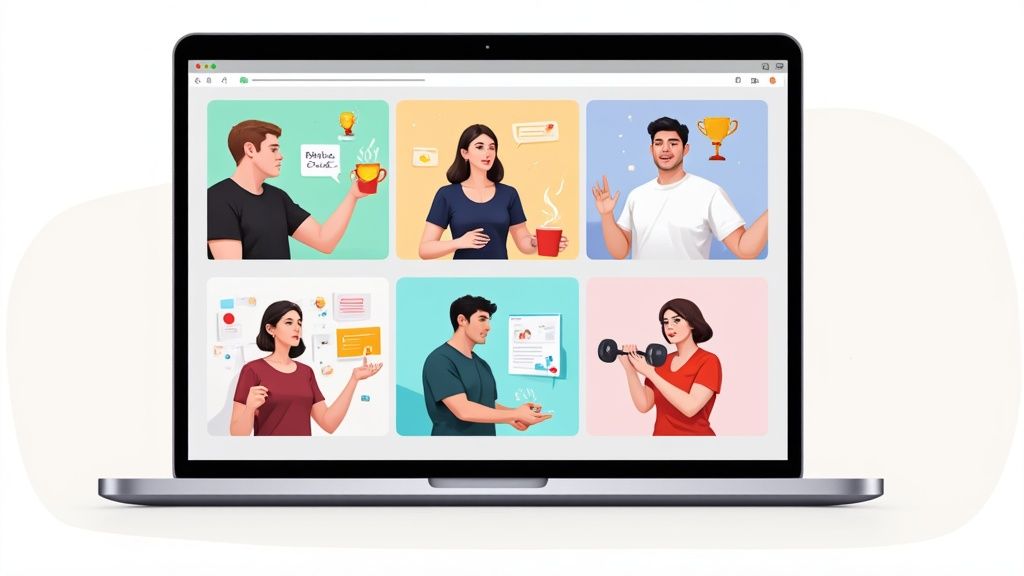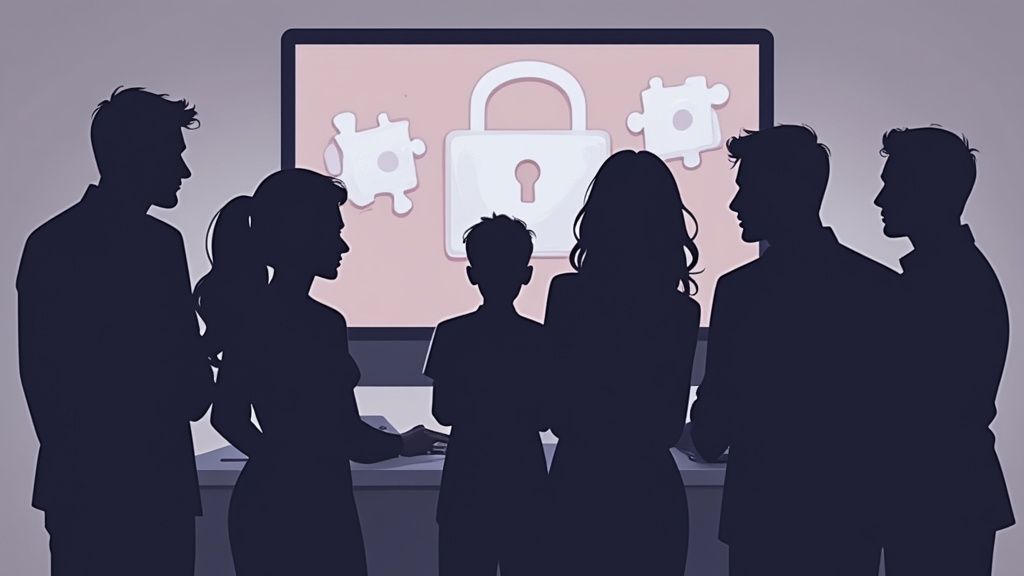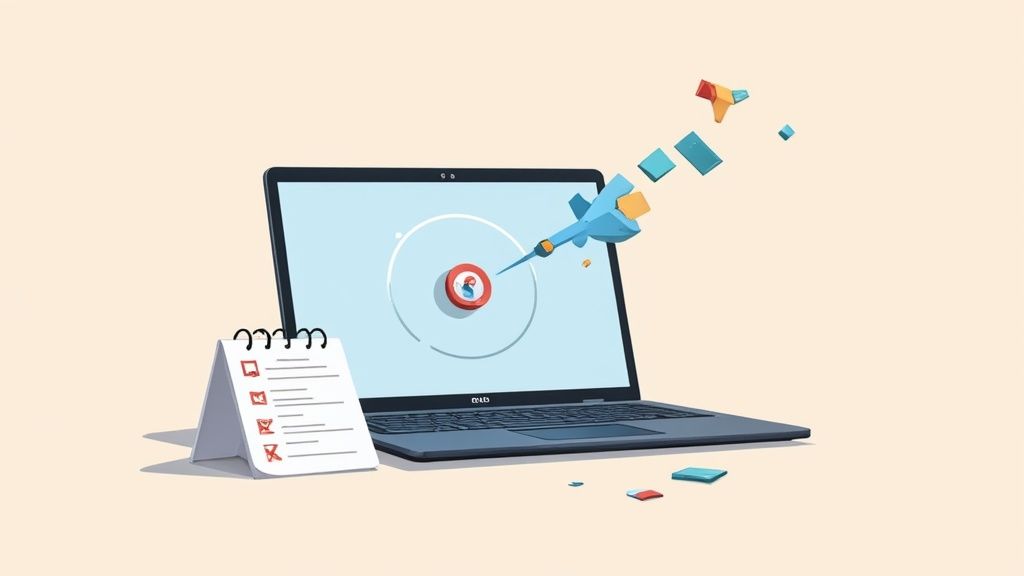
The shift to remote and hybrid work models has revolutionized productivity, but it has also created a new challenge: maintaining a strong, cohesive company culture across physical distances. Without the spontaneous interactions of an office, such as shared coffee breaks or water cooler chats, employees can feel isolated, disconnected, and less engaged. This digital distance can impact morale, collaboration, and ultimately, retention. The solution lies in being intentional about fostering connection.
Cultivating these bonds requires more than just scheduled meetings; it demands a proactive approach. There are many effective ways to promote remote team connection, from establishing communication rituals to recognizing achievements publicly. This article provides a comprehensive roundup of 10 impactful virtual employee engagement activities designed to bridge that gap and build a stronger, more unified team.
We'll move beyond generic advice to offer actionable strategies, practical examples, and implementation tips for each activity. Whether you're managing a tech startup with remote developers, a creative agency, or a large enterprise, you will find ready-to-implement ideas to build a thriving, engaged workforce. These aren't just fun diversions; they are strategic tools for cultivating a positive and productive virtual environment.
Virtual escape rooms are one of the most immersive and collaborative virtual employee engagement activities available today. These online adventures transport teams into a story-driven scenario where they must work together to find clues, decipher puzzles, and solve a central mystery before time runs out. Facilitated through video conferencing and specialized interactive platforms, these games require sharp communication, critical thinking, and collective problem-solving to succeed.

This activity is ideal for breaking down communication barriers and strengthening team dynamics in a high-energy, low-stakes environment. It moves beyond typical virtual happy hours by creating a shared goal that requires active participation from everyone. Companies like Google and Microsoft have used offerings from providers such as The Escape Game to foster collaboration among their distributed teams.
Online trivia competitions are classic, highly effective virtual employee engagement activities that spark friendly competition and build camaraderie. Using specialized platforms or video conferencing tools, teams or individuals face off to answer questions across various categories, from pop culture and general knowledge to company-specific history and industry facts. The fast-paced, game-show format creates a lively and inclusive atmosphere where everyone can participate.

This activity is excellent for a quick morale boost and reinforcing company culture in a fun, non-intrusive way. It requires minimal preparation and can be adapted for any team size or budget, making it a flexible option for regular engagement. Tech giants like Microsoft and Spotify famously use platforms like Kahoot! to energize their global teams, demonstrating the scalability and impact of a well-run trivia session.
Replicating the spontaneous "water cooler" moments of a physical office is a significant challenge in remote work, yet it is crucial for building personal connections. Virtual coffee chats are structured yet informal sessions designed to fill this gap, making them one of the most effective virtual employee engagement activities for fostering a connected culture. These short, agenda-free video calls give colleagues a dedicated space to chat about non-work topics, strengthening social bonds and combating isolation.

This activity is perfect for building camaraderie and trust across different departments, especially in globally distributed teams. It provides a low-pressure environment for employees to get to know each other on a personal level, which enhances collaboration and empathy. Companies renowned for their remote-first cultures, like GitLab and Buffer, have successfully integrated similar programs, such as automated coffee chat pairings and dedicated social channels, to maintain a strong sense of community.
Digital talent shows are vibrant and personal virtual employee engagement activities that allow team members to share their unique hobbies, skills, and creative passions. These virtual events offer a stage for employees to connect on a human level, moving beyond professional roles to reveal hidden talents in music, art, cooking, comedy, or any other area. Facilitated via video conferencing, these showcases can feature live performances, pre-recorded videos, or digital art presentations, celebrating the diverse personalities within the team.

This activity is exceptionally effective for fostering psychological safety and building a culture of appreciation. It highlights individual uniqueness and creates memorable shared experiences that strengthen personal bonds among remote colleagues. Companies with strong creative cultures, like Adobe and HubSpot, have used virtual talent shows and open mic nights to maintain a connected and supportive community, proving that professional respect grows when personal passions are shared and celebrated.
Remote team building games and icebreakers are structured, interactive virtual employee engagement activities designed to help team members connect on a personal level. These activities range from quick, 5-minute warm-ups to more involved exercises, all aimed at building trust and improving communication in a virtual setting. By creating shared, lighthearted experiences, they break down the formality of remote work and foster genuine relationships.
This approach is perfect for kicking off meetings, integrating new hires, or holding standalone team-building sessions. It provides a structured way to encourage interaction beyond work tasks, which is vital for maintaining a strong team dynamic. Companies like Zoom have facilitated this by integrating features like breakout rooms and whiteboards, while providers such as TeamBuilding.com offer a vast catalog of guided virtual games. These activities are essential for creating a positive and collaborative work culture among distributed teams.
Virtual Lunch and Learn sessions are one of the most effective virtual employee engagement activities for blending professional development with social interaction. These informal meetings occur over lunchtime, where team members can eat together on camera while listening to a presentation or participating in a discussion. The topics can range from work-related skills and industry trends to personal hobbies and wellness, creating a relaxed environment for continuous learning.
This activity is perfect for fostering a culture of curiosity and knowledge sharing without adding another formal meeting to the calendar. It empowers employees to learn new skills while connecting with colleagues on a more personal level. Companies like Google and Salesforce have successfully used this model, hosting everything from internal tech talks to sessions with industry experts, demonstrating its value in both skill enhancement and community building.
Online gaming tournaments are fantastic virtual employee engagement activities that tap into the universal appeal of friendly competition. These organized events bring colleagues together to compete in accessible online games, creating a shared experience that builds camaraderie and offers a powerful form of stress relief. From collaborative problem-solving in games like Among Us to strategic showdowns on Chess.com, tournaments can be tailored to fit any team culture.
This activity excels at fostering informal connections and team spirit outside of work-related tasks. It allows employees with different roles and seniority levels to interact on a level playing field, boosting morale and creating lasting memories. The rise of accessible platforms like Jackbox Games has made it incredibly easy for companies to host inclusive, laughter-filled gaming sessions that require no prior gaming experience.
Virtual book clubs are structured and intellectually stimulating virtual employee engagement activities that foster deep connections through shared learning. In these groups, employees read a selected book, article, or industry report and meet online to discuss key takeaways, challenge assumptions, and share diverse perspectives. This format moves beyond casual small talk, creating a dedicated space for meaningful conversation and professional development.
This activity is perfect for building a culture of continuous learning and connecting employees who share intellectual interests. It provides a low-pressure environment for team members from different departments to interact and build rapport based on shared ideas rather than just work tasks. Companies like Amazon have famously used internal book clubs to dissect leadership principles, while Microsoft has leveraged them to drive important diversity and inclusion conversations.
Promoting health-focused initiatives is a powerful way to engage remote staff, and digital wellness challenges are excellent virtual employee engagement activities for this purpose. These programs encourage physical and mental well-being through group challenges, shared fitness classes, or mindfulness sessions. By creating a community around shared wellness goals, companies can support healthier habits, reduce stress, and show employees they care about their overall well-being beyond work tasks.
This activity is ideal for fostering a supportive culture and combating the sedentary nature of remote work. It builds camaraderie in a non-work context and can significantly boost morale and energy levels. Companies like Peloton and Headspace for Business have popularized corporate wellness programs that make high-quality fitness and meditation accessible to distributed teams, creating a sense of connection through shared progress.
Interactive virtual workshops are powerful virtual employee engagement activities that blend professional development with team-based collaboration. These sessions go beyond passive learning by guiding employees through hands-on exercises, collaborative projects, and skill application in real-time. Facilitated through platforms like Miro or Mural alongside video conferencing, workshops can cover topics from design thinking and coding to leadership development, creating an environment where teams learn and grow together.
This activity is perfect for investing in your team's capabilities while strengthening their collaborative bonds. It demonstrates a commitment to employee growth and provides a structured break from routine tasks. Organizations like General Assembly-for-business have excelled at delivering high-impact skill development, proving that upskilling can be a highly engaging and interactive team experience, even in a remote setting.
| Activity Type | Implementation Complexity | Resource Requirements | Expected Outcomes | Ideal Use Cases | Key Advantages |
|---|---|---|---|---|---|
| Virtual Escape Rooms | High – needs professional facilitation and tech setup | High – specialized software, stable internet | Improved teamwork, communication, creative problem-solving | Team collaboration, remote teams seeking engagement | Promotes teamwork, measurable outcomes, no location limits |
| Online Trivia Competitions | Low – easy setup, requires good question prep | Low – quiz platforms, minimal tech | Friendly competition, knowledge sharing | Quick engagement, large scalable groups | Low cost, scalable, incorporates company culture |
| Virtual Coffee Chats and Water Cooler Sessions | Low – informal, unstructured | Low – video conferencing tools | Personal connection, reduced isolation | Casual socializing, introverted employees | Inclusive, flexible, builds relationships |
| Digital Talent Shows and Creative Showcases | Medium – event coordination and technical support | Medium – video tools, production support | Increased personal connection, confidence boost | Celebrating diversity, creative expression | Engaging, memorable, celebrates individuality |
| Remote Team Building Games and Icebreakers | Low – simple activities, minimal tech | Low – video conferencing features | Improved communication, trust building | Meetings, onboarding, quick engagement | Easy to implement, customizable, cost-effective |
| Virtual Lunch and Learn Sessions | Medium – requires speaker coordination | Medium – speaker time, presentation tools | Professional development combined with social interaction | Learning culture, skill development | Efficient use of time, networking, knowledge sharing |
| Online Gaming Tournaments | Medium to High – tournament structure management | Medium – gaming platforms, software | Team spirit, stress relief, friendly competition | Gaming enthusiasts, long-term engagement | Appeals to diverse gamers, ongoing engagement |
| Virtual Book Clubs and Discussion Groups | Medium – requires facilitation and consistent scheduling | Low to Medium – reading materials, meeting tools | Intellectual growth, deep discussions | Continuous learning, knowledge-building | Encourages learning, diverse formats, ongoing engagement |
| Digital Wellness and Fitness Challenges | Medium – ongoing program management | Medium – tracking apps, wellness platforms | Improved well-being, team support | Health-focused employee engagement | Promotes health, stress relief, inclusive |
| Interactive Virtual Workshops and Skill-Building Sessions | High – expert facilitation and planning | High – software, expert instructors | Skill development, team collaboration | Professional development, upskilling | Hands-on learning, tailored content, builds team bonds |
The journey through this extensive list of virtual employee engagement activities reveals a powerful truth: fostering a connected, vibrant remote culture is not about a single grand gesture. Instead, it is about the consistent, intentional weaving of meaningful interactions into the fabric of the daily work experience. From the competitive thrill of online trivia and gaming tournaments to the collaborative problem-solving of virtual escape rooms, each activity offers a unique thread to strengthen team bonds.
The key to success lies not in implementing every idea, but in curating a diverse and strategic program. A healthy mix of activities, such as intellectual Lunch and Learns, creative talent showcases, and informal virtual coffee chats, ensures that you cater to a wide range of personalities and preferences. This variety prevents engagement from feeling like a mandatory chore and transforms it into a genuine opportunity for connection that employees will actively seek out.
Moving forward, the goal is to translate inspiration into a sustainable engagement strategy. Don't let this list become just another bookmarked article. Take decisive action to build momentum and create a more connected virtual workplace.
Here are your immediate next steps:
Investing in these activities is an investment in your company's most valuable asset: its people. A highly engaged remote team is more than just productive; it is innovative, resilient, and deeply committed to shared goals. When employees feel seen, valued, and connected to their colleagues, they are more likely to collaborate effectively, support one another, and remain loyal to the organization. This sense of belonging is the bedrock of a thriving remote-first culture.
As you develop your internal engagement calendar, remember that inspiration can come from many places. For broader inspiration on fostering team camaraderie, exploring various corporate event entertainment ideas can provide a wealth of options adaptable for virtual engagement. Ultimately, the activities themselves are simply the tools. The real objective is to create an environment where every employee, regardless of their physical location, feels like an integral part of a unified and supportive community. By prioritizing this human connection, you build a stronger, more successful organization from the inside out.
